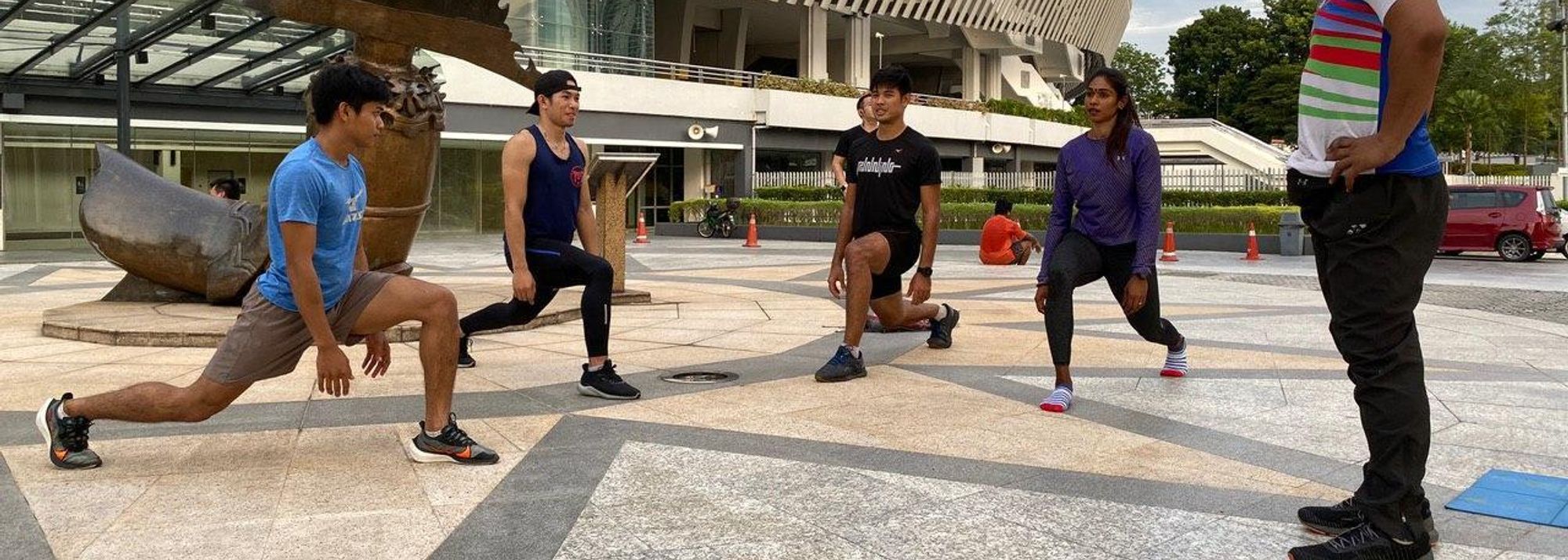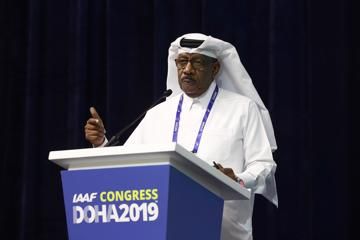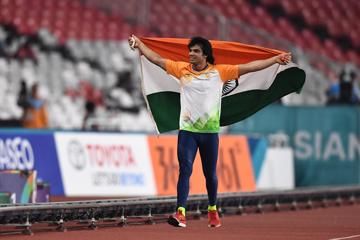Malaysian long and triple jumpers with coach Firdaus Salim (© Jad Adrian Washif)
In light of the concerns and evolving nature of the coronavirus Covid-19 pandemic, most countries have taken measures to slow the spread of the disease by implementing social and physical distancing, movement restrictions and lockdown.
Such preventative measures have also impacted the world’s sporting calendar since early 2020, as well as athletes’ training options. But to some extent, it also provided opportunities for coaches to sharpen their knowledge and skills.
Many athletics coaches in Asia have utilised this ‘period of isolation’ by participating in initiatives organised by various sports agencies that aimed to further the development of coaches in the Area.
Learning to use available tools
The Area Development Centre (ADC) in Jakarta introduced an online development program through courses attended by World Athletics certified coaches from several Asian nations.
Course coordinator, Ria Lumintuarso, said two courses were recently organised. The first, held on 9-10 June, focused on ways to help coaches further their understanding of available technology to improve their own online coaching methods and creativity. The second, held on 19-22 June, focused on strength and conditioning.
“We would like our coaches to be creative so that they are able to do something (in coaching),” Lumintuarso said. “Our coaches should be able to make use of the current situation to be better, not ‘being used by it’. So they have to adapt to the situation and be able to run an online course.”
Anbarasu Subramaniam, a course participant from Malaysia and senior World Athletics lecturer, said, “We were taught how to use apps such as Video Editor, how to add videos to a project library and storyboard, add a title card, trimming, splitting, adding text, 3D effects, filter speed, and background music.”
In both courses, participants were required to apply the knowledge they gained to produce a three-minute video about a specific training task given to each sub-group of course participants.
“The training videos we created would be used as a practical session for the subsequent online courses we would be conducting,” said Subramaniam, who then co-conducted an online World Athletics Kids’ Athletics course with 30 coaches in Kuala Lumpur from 17-21 June.
Expanded courses, ambitious plans in India
In India, a series of online courses and workshops were conducted for local coaches as well as invited attendees from several other countries.
The Athletics Federation of India (AFI) invited ex-athletes and experts from different areas of coaching and sports sciences to help course participants achieve their coaching goals.
AFI President and World Athletics Council Member Adille Sumariwalla, said the initial focus of the workshops in April and May was on the Basic Foundation Course.
“Part of it was the syllabus of the World Athletics Level 1 course, and we did it as a ‘course refresher’ for all coaches,” Sumariwalla said.
“In early June, we shifted our focus more into specific topics such as how to keep safe during the lockdown, learning sports nutrition, sports biomechanics, diet and nutrition, strength training, anti-doping, and so on.
“So we started to engage with experts like Dr Klaus Bartonietz, and former top athletes (now coaching) including Uwe Hohn for throwing events, and Galina Bukharina for sprint events.”
Sumariwalla explained that each seminar would take two to three hours, and was held five to six times a week since March. “We would receive 50 to 60 questions after every seminar, forcing the course’s lecturers to reply via email because of time limitations.”
“We want coaches in India to have the knowledge required for successful coaching. We don’t want them to continue with unscientific approaches that could lead to burnout of our young athletes.”
The AFI extended its program to invite coaches from neighbouring countries to also participate.
“One of our goals for the next two years is to have at least five thousands track and field coaches with at least a Level I credential from World Athletics,” Sumariwalla said. “This figure seems out of boundary but it is actually the minimum. There are over 700 districts in India and having seven or eight coaches per district, on average, is more than achievable.”
Increased opportunities for women coaches
Online courses and seminars allow remote learning that can provide an alternative to traditional classes, which is needed for the current situation where only online means of group interaction are considered practical.
“This is a good chance for all, especially female coaches, to attend seminars to boost their coaching knowledge, as people don’t need to travel to gain the same knowledge,” said Mumtaz Jaafar, former national sprint queen and deputy president of Malaysian Athletics Federation, during the Kids’ Athletics course.
“We would like to see more females become involved in coaching, and an online seminar is probably the best way to attract them to learn and engage more in coaching,” Jaafar said.
Roselyn Hamero, a throws coach from the Philippines, has fully utilised the lockdown period to improve her expertise. Hamero has attended dozens of online trainings in recent months, including the World Athletics workshops for lecturers, and other webinars related to training, coaching, sports science, health and wellness. She also attended webinars for online presentation and organisation, to help her improve her online coaching presentations.
“Since we couldn’t do a face-to-face training in the next several months, I have been planning to create e-coaching system for my athletes,” Hamero said.
“I was able to adjust from face-to-face lecturing to online lecturing (webinar). The training that I have done, such as that of making instructional workout video for my athletes, has enabled me to carry out distance coaching by using different platformd to coach, monitor and assess my athletes.”
“I have also shared what I have learnt with others, like Covid-19 awareness. I can now incorporate a lot of the new skills I have learnt,” she adds.
More time for supplemental learning
Malaysian jumps coach Firdaus Salim said he took advantage of lockdown by doing some online reading and learning from fitness coaches on YouTube.
“I plan to improve my athletes by focusing on the very basic skills and movements related to long and triple jumping, including injury prevention,” said Salims.
“I have been analysing the components related to my athletes’ events, studying their movements, and try to prescribe basic and fundamental exercises and training for them, without having to think too much about performance at this moment,” he adds.
In Singapore, World Athletics Academy coach and Club Zoom President Tan Wei Leong has organised weekly Zoom sessions focusing on sharing “expert tips” among coaches, which has attracted participants - coaches and athletes - from the USA, Bahamas, Canada, India, Malaysia and Nepal.
“Since everyone is stuck at home, my athletes' morale needed uplifting and I had connections to coaches around the world from my Level V course in the USA,” Tan said. “Why not bring everyone together online?”
“My own Club Zoom has been holding our 'Kindred Spirit Series' (track & field) meets for the last six years, but this year, we'll be doing a 'Virtual Challenge' that will be open to participants worldwide. So Covid-19 really has helped us expand our outreach in promoting sporting values and friendships. That's ‘when life gives you lemons, you make lemonade’.”
Other coaches in Singapore have also found that the lockdown period has given a great opportunity to develop themselves via webinars.
Coach education initiatives have been organised in Singapore via webinars where local experts were invited to share knowledge and views regarding training, said coach C. Veeramani.
“Online means have heightened globally, and everything has gone online with no exception. Online courses can improve outreach. Such webinars would involve close to 200 participants, usually recorded, and we have the opportunity to view the content anytime.”
Despite access restrictions to stadium tracks and recovery facilities, some athletes, especially distance runners, have been able to perform most of their training and running activities in alignment with local social distancing measures.
“This includes utilisation of readily available apps to monitor heart rate, tracking of bar velocity for gym works, and so on, which can be done by athletes or coaches themselves,” said Veeramani.
“Some coaches may still be catching up with technology and learning how to use the apps, and this is where coaches like myself, need to be abruptly encouraged to seek extra coaching education,” he said.
Ekkawit Sawangphol of Thailand, who has coached multiple Asian champions in sprint events, said the situation has been much better in Thailand since early April with a small pool of national athletes were allowed to train as usual.
“The competitions will be very few, but there’s no need to rush,” he said. “Coaches can spend more time for preparation, progressing step by step, and follow a proper periodisation.”
“For the coaches, we began with two classroom workshops in June at Bangkok and Nakhon Sawan. But we are pretty much occupied from now until the end of the year with coaching courses and clinics,” he adds.
Survey suggests strong growth of online coaching and learning
Meanwhile, a trend exists among coaches in utilising online training videos shared on the social media sites such as YouTube for learning and development initiatives.
According to a survey* conducted on 25-26 June of 142 active coaches from the Philippines (38%), Malaysia (35%), and Singapore (23%), 76% said that they regulary use sites such as YouTube for elearning initatives. Around 70% said they have participated in online seminars or workshops while 63% indicated that they have read training books and/or articles during the lockdown period. About 60% have done ‘reflection’ to identify their strengths and weaknesses in coaching. Meanwhile, only 37% indicated that they have connected with their fellow coaches, while 35% engaged with training experts and/or sports scientists to discuss training and coaching.
There are of course limitations.
“The main challenge when using video to train athletes is when changes or details about spontaneous correction are required, especially technical errors,” one coach said.
Other challenges with online coaching include difficulty to fully observe training during times when internet connections are poor or not being sufficiently familiar with online gadgets and tools. Motivating athletes can also be difficult.
However, 67% of the surveyed participants “agreed or strongly agreed” that coaching by correspondence (e.g. video conferencing) is effective, and 61% “agreed or strongly agreed” that using such a technology in coaching is not difficult.
Jad Adrian Washif for World Athletics
*The survey was conducted independently by the author of this story. We thank him for his efforts to help draw a clearer picture of coaching practices and methods used in parts of Asia during the coronavirus pandemic period.






